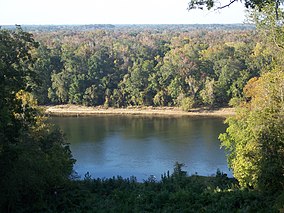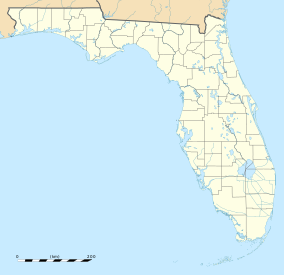| This article needs additional citations for verification. Please help improve this article by adding citations to reliable sources. Unsourced material may be challenged and removed. Find sources: "Torreya State Park" – news · newspapers · books · scholar · JSTOR (July 2022) (Learn how and when to remove this message) |
| Torreya State Park | |
|---|---|
| IUCN category V (protected landscape/seascape) | |
 View of the Apalachicola River from bluffs View of the Apalachicola River from bluffsin Torreya State Park | |
  | |
| Location | Liberty County, Florida, United States |
| Nearest city | Bristol, Florida |
| Coordinates | 30°34′08″N 84°56′53″W / 30.56889°N 84.94806°W / 30.56889; -84.94806 |
| Area | 13,735 acres (55.58 km) |
| Governing body | Florida Department of Environmental Protection |
| U.S. National Natural Landmark | |
| Designated | December 1976 |
Torreya State Park is a 13,735 acre (56 km) Florida State Park, United States National Natural Landmark and historic site thirteen miles (19 km) north of Bristol. It is located north of S.R 12 on the Apalachicola River, in northwestern Florida (Florida Panhandle), at 2576 N.W. Torreya Park Road.
It was named for the Florida Nutmeg (Torreya taxifolia) trees, a rare species of Torreya tree endemic to the local east bank of the Apalachicola River's limestone bluffs.
Geography
With river swamps and high pinelands, extensive ravines and high bluffs along the river, the park has one of the most variable terrains of any in Florida. The high elevation of the park is about 300 feet at the top of Logan Hill. Many streams run through the park.
History
Torreya State Park is one of the original Florida state parks developed by the Civilian Conservation Corps during the Great Depression. The park was named for the Florida tree Torreya taxifolia. Due to the river's importance during the Civil War, a six-cannon battery was placed on a bluff to prevent the passage of Union gunboats. These cannons never saw combat action at this location. The gun pits' remains can still be seen in the park.
Prior Native American inhabitation has been confirmed by archaeological discoveries in the area.
In 1818, General Andrew Jackson and his army crossed the Apalachicola here during the First Seminole War. Ten years later, the first government road to cross the new Territory met the river here.
Gregory House

In 1849, Jason Gregory built a plantation house at Ocheesee Landing, across from the park's current location. After the Civil War, like most plantations, it fell into disuse.
Not long after the Civilian Conservation Corps was established in 1933, they started work to create the park. Part of the project in 1935 was disassembling the old Gregory House, moving it across the river and reconstructing it in the park, where it stands today. Visitors can tour the Gregory House for a small fee.
Hurricanes and Torreya State Park
On October 10 2018, the eye of Hurricane Michael tracked a few miles west of the park, producing sustained winds well within hurricane force. Catastrophic damage occurred within the park and its surrounding area. Trees were either felled, snapped, or stripped of branches, so thinning the tree canopy to a high degree. The park was closed for the remainder of autumn and all through winter as staff toiled to cut hazardous trees and clear fallen wood. However, many of the Florida nutmeg trees under park protection survived.
Hurricane Helene struck northwestern Florida on September 26, 2024, with its eye tracking just east of the park. Damage was considerable and the park was closed indefinitely.
Natural history
Flora
The park is one of the few places in Florida where the endangered species Few-flowered croomia (Croomia pauciflora) can still be found. Other endangered species of Florida in the park include the feathery false lily of the valley (Maianthemum racemosum), Canadian honewort (Cryptotaenia canadensis), and bloodroot (Sanguinaria canadensis).
The varieties of hardwood trees include Southern live oak (Quercus virginiana), White oak (Quercus alba), Water hickory (Carya aquatica), Southern wax myrtle (Myrica cerifera), Sourwood (Oxydendrum arboreum), American beech (Fagus grandifolia), Tulip tree (Liriodendron tulipifera), Florida maple (Acer floridanum), and Sweetgum (Liquidambar styraciflua). Species of softwood trees include the variety of both Needle palm (Rhapidophyllum hystrix) and Dwarf palmetto (Sabal minor), Loblolly pine (Pinus taeda), Longleaf pine (Pinus palustris), and Redbay (Persea borbonia).
The endemic Florida Nutmeg (Torreya taxifolia) trees are restricted to the limestone bluffs and their ravines within Torreya State Park, along the east bank of the Apalachicola River in northern Florida and southern Georgia. It was one of the first federally listed endangered plant species in the United States in 1984. It is a Critically endangered species on the IUCN Red List, due to estimated 98% decline in mature individuals within the last three generations. Its total extent of occurrence is estimated to be about only 200 square kilometres (49,000 acres). The Apalachicola valley served as a refugium for T. taxifola during the last ice age, when its range shrank due to cooler temperatures.
Another critically endangered species found within Torreya State Park is the Florida Yew (Taxus floridana). Also endemic to the east bank of the Apalachicola River, the Florida yew has a similar appearance to the Florida nutmeg. The yew can be differentiated by the shorter, blunt-tipped (not spine-tipped) leaves and the less strong smell of the crushed leaves.
Fauna
Many animals can be seen in the park. Some of the mammals there include deer, squirrel, raccoon, opossum, fox, skunk, rabbit, bobcat and black bear. Dozens of species of birds can be viewed. Numerous species of amphibians and reptiles exist there as well, such as the Eastern Hognose Snake, gopher tortoises, and the rare Apalachicola dusky salamander. Hazardous fauna include alligator, copperhead, cottonmouth, rattlesnakes, and ticks.
Recreational activities
The park has such amenities as birding, boating, hiking, picnicking, wildlife viewing and full camping facilities. It also has concessions, a museum and interpretive exhibit.
The Apalachicola River Bluffs Trail, a National Recreational Trail, is part of the park.
Gallery
-
 Entrance to Torreya State Park
Entrance to Torreya State Park
-
 Gregory House at Torreya State Park
Gregory House at Torreya State Park
-
 View of the Apalachicola River in Torreya State Park
View of the Apalachicola River in Torreya State Park
-
 View of the Apalachicola River in Torreya State Park
View of the Apalachicola River in Torreya State Park
References
- "History". Florida State Parks.
- "Torreya State Park: Other Highlights - Liberty County, Florida". ExploreSouthernHistory.
- "History". Florida State Parks.
- "Hurricane Recovery- Torreya State Park | Florida State Parks". www.floridastateparks.org. Retrieved December 8, 2024.
- "Torreya State Park | Florida State Parks". www.floridastateparks.org. Retrieved December 8, 2024.
- NRCS. "Croomia pauciflora". PLANTS Database. United States Department of Agriculture (USDA).
- "NSIS: Florida's Native Plants - Protected: C-D". www.nsis.org. Retrieved December 8, 2024.
- "USDA Plants Database". plants.usda.gov. Retrieved December 8, 2024.
- "The IUCN Red List of Threatened Species". IUCN Red List of Threatened Species. Retrieved October 28, 2018.
- Barlow, Connie (April 2019). "At the Brink of Extinction — Why? Part 3. Assisted Migration of Glacial Relicts, Not Genetic Engineering". Torreya Guardians. Retrieved June 24, 2020.
- "Torreya State Park: Other Highlights - Liberty County, Florida". ExploreSouthernHistory.
External links
- Official website

- Torreya State Park at Florida State Parks
- Torreya State Park at State Parks
- Torreya State Park Trails at Florida Department of Environmental Protection
- A Special Place at A Glimpse of Florida
- Explore Southern History: Torreya State Park Archived June 10, 2009, at the Wayback Machine – includes information on Gregory House
| U.S. National Register of Historic Places in Florida | ||
|---|---|---|
| Lists by county |
|   |
| Lists by city | ||
| Other lists | ||
- IUCN Category V
- State parks of Florida
- Parks in Liberty County, Florida
- Museums in Liberty County, Florida
- Historic house museums in Florida
- Plantation houses in Florida
- Farm museums in Florida
- American Civil War museums in Florida
- Military and war museums in Florida
- Houses in Liberty County, Florida
- National Register of Historic Places in Liberty County, Florida
- National Natural Landmarks in Florida
- Protected areas established in 1935
- Civilian Conservation Corps in Florida
- 1976 establishments in Florida
- 1935 establishments in Florida
- National Park Service rustic in Florida